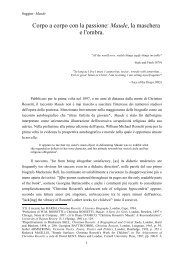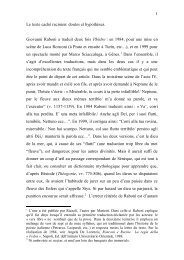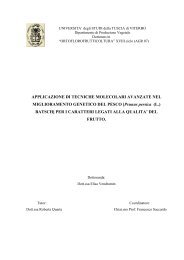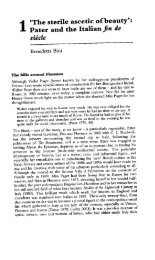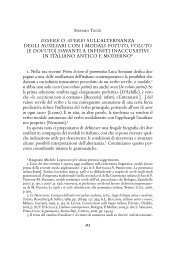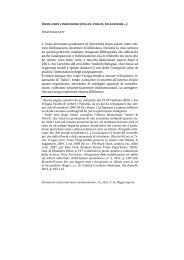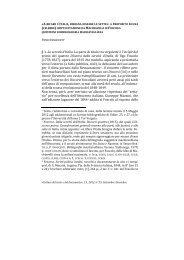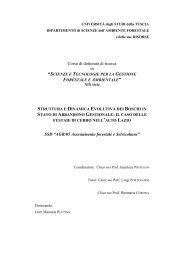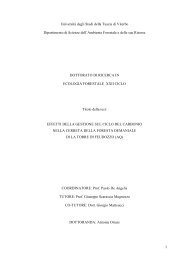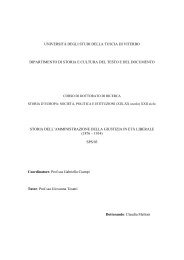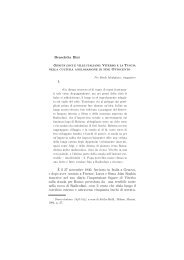drivers of soil respiration of root and microbial ... - Unitus DSpace
drivers of soil respiration of root and microbial ... - Unitus DSpace
drivers of soil respiration of root and microbial ... - Unitus DSpace
You also want an ePaper? Increase the reach of your titles
YUMPU automatically turns print PDFs into web optimized ePapers that Google loves.
Abstract<br />
Soil historically has been a major source <strong>of</strong> atmospheric enrichment <strong>of</strong> CO2 <strong>and</strong> in the same<br />
time is one <strong>of</strong> the biggest storing reservoirs <strong>of</strong> carbon on the global scale. In fact, <strong>soil</strong>s hold three<br />
times as much carbon as the terrestrial biosphere <strong>and</strong> about twice as much as the atmosphere <strong>and</strong><br />
exert a large influence on the cycling <strong>of</strong> carbon between different pools. Soil <strong>respiration</strong>, which is<br />
the flux <strong>of</strong> CO2 from <strong>soil</strong>s to the atmosphere, is thus an important component <strong>of</strong> the ecosystem C<br />
budgets <strong>and</strong> is a major source <strong>of</strong> CO2 released by terrestrial ecosystems. Soil <strong>respiration</strong> is the result<br />
<strong>of</strong> the production <strong>of</strong> CO2 from the biological activity <strong>of</strong> <strong>root</strong>s <strong>and</strong> associated microorganisms <strong>and</strong><br />
the activity <strong>of</strong> heterotrophic bacteria <strong>and</strong> fungi living on litter <strong>and</strong> in the <strong>root</strong>-free <strong>soil</strong>. Different<br />
sources <strong>of</strong> <strong>soil</strong> CO2 efflux are known to experience high spatial <strong>and</strong> temporal variation with<br />
different controlling factors involved on different time-scales. However, up to now not so many<br />
studies have deal with the interannual variability <strong>of</strong> <strong>soil</strong> <strong>respiration</strong> <strong>and</strong> its components <strong>and</strong> only<br />
few <strong>of</strong> them were performed in grassl<strong>and</strong> ecosystems despite the fact that it is one <strong>of</strong> the world’s<br />
most widespread vegetation types which comprises 32% <strong>of</strong> the earth’s area <strong>of</strong> natural vegetation.<br />
This study aimed to advance the underst<strong>and</strong>ing <strong>of</strong> the processes <strong>and</strong> factors controlling the<br />
behaviour <strong>of</strong> different <strong>soil</strong> <strong>respiration</strong> sources in grassl<strong>and</strong> ecosystems. It provides the analysis <strong>of</strong><br />
the response <strong>of</strong> <strong>soil</strong> CO2 efflux <strong>and</strong> its components: <strong>root</strong>- <strong>and</strong> <strong>microbial</strong>-derived <strong>respiration</strong> to<br />
different biotic <strong>and</strong> abiotic factors as well as to widely diffused management activities over a period<br />
<strong>of</strong> three years in a mediterranean grassl<strong>and</strong> site <strong>and</strong> integrates also different laboratory <strong>and</strong> in situ<br />
methodological approaches for deeper studying <strong>of</strong> the contribution <strong>of</strong> various <strong>respiration</strong> sources to<br />
total CO2 efflux from <strong>soil</strong> <strong>and</strong> the speed <strong>of</strong> C cycling within the plant community.<br />
Soil <strong>respiration</strong> was partitioned in the field using micro (1µm) <strong>and</strong> macro (1 cm) pore<br />
meshes. Soil <strong>respiration</strong> obtained from the cores with different pore-sized meshes <strong>and</strong> from the<br />
control undisturbed <strong>soil</strong> were used to calculate values <strong>of</strong> <strong>root</strong>-derived <strong>and</strong> <strong>microbial</strong>-derived<br />
<strong>respiration</strong> sources. These fluxes were then related to canopy photosynthetic activity, <strong>soil</strong><br />
temperature, <strong>soil</strong> moisture <strong>and</strong> some <strong>soil</strong> biochemical parameters.<br />
Methodological approach based on pulse labeling <strong>of</strong> plants in artificial 13 CO2 or 14 CO2<br />
atmosphere was used to found out the speed <strong>of</strong> the cycling <strong>of</strong> C in grassl<strong>and</strong> ecosystem (in situ) as<br />
well as to study the effect <strong>of</strong> different plant species, plant growing stages, <strong>and</strong> different nutrient<br />
supply on the magnitude <strong>of</strong> <strong>root</strong> <strong>respiration</strong> <strong>and</strong> on the speed <strong>of</strong> translocation <strong>and</strong> <strong>respiration</strong> <strong>of</strong><br />
recently assimilated C through <strong>root</strong>s (on a single species, in laboratory).<br />
The obtained results showed an importance <strong>of</strong> C assimilate supply in the determination <strong>of</strong><br />
the variability <strong>of</strong> <strong>root</strong> component <strong>of</strong> <strong>soil</strong> <strong>respiration</strong>. It was closely related to gross primary<br />
production with a time lag <strong>of</strong> circa 20h for time scales from daily to annual. Soil temperature which<br />
<strong>of</strong>ten masks the direct relationship between <strong>root</strong> <strong>respiration</strong> <strong>and</strong> photosynthetic C supply failed to<br />
3




